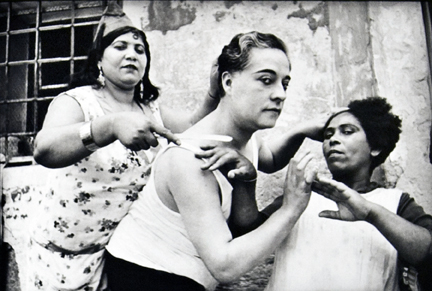About the Photographer
Cartier-Bresson, Henri
French, 1908-2004
"I suddenly understood that photography can fix eternity in a moment."
Son of a wealthy textile manufacturer, Henri Cartier-Bresson turned away from this heritage and in the 1920s immersed himself in the world of the Parisian avant-garde, where he came to know artists and writers such as André Breton, Max Ernst and Jean Concteau. Engrossed first by Cubism, and then to a greater degree by Surrealism, Cartier-Bresson began studying painting at André Lhote's academy in 1927. Within a few years, however, he had discovered photography and shifted course, beginning one of the most groundbreaking photographic careers of the twentieth century. Surrealism would continue to be an influence throughout his life, and his photographs reflect a sense of formal order that draws from his experience as a painter. In 1932, Cartier-Bresson replaced the camera he had used on his early trips abroad with a Leica, the portable 35mm camera that he would quickly master and which would be his signature camera for nearly forty years.
A seminal figure in the rise of photojournalism, Cartier-Bresson's reportage was grounded in a complex synthesis of form and content. Cartier-Bresson recalled that he took to the streets, "determined to 'trap' life—to preserve life in the act of living." He saw the camera as an extension of his eye and sought to pinpoint l'instant décisif, or "the decisive moment," in which an unfolding situation is expressed fully in the image's composition for a split second. Although he was consistently reluctant to outline a programmatic theory of photography, he describes this idea in the preface of his landmark monograph Images à la sauvette (1952), stating, "To take photographs means to recognize—simultaneously and within a fraction of a second—both the fact itself and the rigorous organization of visually perceived forms that give it meaning. It is putting one's head, one's eye and one's heart on the same axis."
When World War II broke out in 1939, Cartier-Bresson joined the French army as a corporal in the film and photo unit. After being taken prisoner by German soldiers when the French army collapsed in June 1940, he spent nearly three years in a Nazi work camp, escaping on his third attempt in February1943. Subsequently he joined the French Resistance and photographed the occupation and liberation of Paris in 1944. Soon after, Cartier-Bresson was commissioned by the U.S. Office of War Information to create the documentary film Le Retour (1945) about the repatriation of former prisoners of war and displaced persons to France. In 1947 a solo exhibition of his work opened at the Museum of Modern Art, New York, originally planned as a memorial retrospective when Cartier-Bresson had been presumed dead in 1942.
Cartier-Bresson co-founded the first cooperative agency of international freelance photographers, Magnum Photos, with Robert Capa, George Rodger, David 'Chim' Seymour, and William Vandivert in 1947. Shortly after, he spent three years traveling in India, China, and Indonesia, as Indonesia gained its independence. (Two photographs taken on the Indonesian islands of Bali and Sumatra are represented in the MoCP's permanent collection.) For the following two decades, Cartier-Bresson worked primarily on assignment for magazines such as LIFE. In the process he documented numerous significant events throughout world, including the death of Gandhi in India, the creation of the People's Republic of China, the period of détente in the USSR, and the 1968 student protests in Paris. Cartier-Bresson resigned from Magnum in 1966, and in 1974 he devoted himself anew to painting and drawing. In 2003 he created the Fondation Henri Cartier-Bresson with his wife, photographer Martine Franck, and his daughter, to ensure the preservation of his work.




